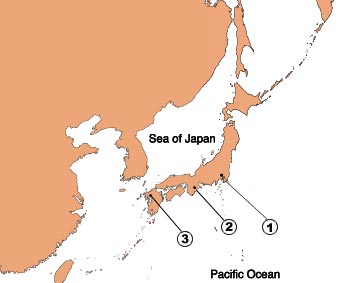| Web Japan > NIPPONIA No.32 > Japan Travelogue |
|
|
|
NIPPONIA No.32 March 15, 2005
|
|
Japan Travelogue |
 |
(1)Tokyo
(2)Osaka
(3)Arita and Imari |
|
Many kilns produce ceramics in western Saga Prefecture, and the most important production center—the birthplace of Japanese porcelain—is Arita. A fine white porcelain clay was discovered there before anywhere else in Japan, and an industry soon sprang up under the control of the feudal lord of the local Nabeshima domain. The ceramics of Arita, a town near the Nagasaki Prefecture border in northwestern Kyushu, spread worldwide.
Voyages of discovery in the 1500s brought Europe and Asia into regular contact, and the West soon learned about China's white porcelain ware with its transparent glaze coating. Ships from the West brought back loads of white porcelain and polychrome picture ware, much to the delight of royalty and aristocrats. Before Arita began making it in the early 1600s, all porcelain used in Japan was imported from China and Korea.
Around this time, China experienced civil strife and a change in dynasties to the Ch'ing (Manchu). Chinese production and distribution of porcelain practically came to a halt, and Arita filled the gap, supplying it to the Dutch East India Company, beginning around 1650.
Porcelain from Arita became known as "Imari ware" because it passed through the nearby port of Imari on its way to foreign countries and other parts of Japan.
Today, the town of Arita stretches along a valley, bordered by large rice fields and low mountains. The main street runs east-west, more or less parallel to National Highway No. 35. Shops line the street on both sides for about 6 km, and many sell blue and white dyed porcelain and picture ware with polychrome designs (mainly reds, yellows and greens). White-walled buildings, imposing wooden houses, slightly run-down buildings constructed in the Western style—you will see these everywhere, attesting to the old days when wholesalers and others kept coming to buy. The most important district for Arita ware is Akae-machi, about halfway along the main street.
The feudal lord of the Nabeshima domain did not want others to learn Arita's secrets, especially how to make the illustrated, glazed porcelain. In 1672 he had all akae-ya (overglaze painters) move to one place, and this became known as Akae-machi. He restricted the number of akae-ya to a dozen or so, and made sure their techniques—everything from dye making to glaze preparation to picture ware overglaze painting—were passed in secret from one generation to the next. The best type became known as Nabeshima ware, and the best of these were given by the lord to the Emperor, Shogun, aristocrats and other feudal lords.
One akae-ya, who operates the Imaizumi Imaemon Kiln today, carries on the old Iro Nabeshima picture ware techniques. The current manufacturer, Imaizumi Imaemon the 14th, says he works carefully to match the style and mood of his products to modern tastes.
In this district everything, even the shrines and temples, seems to have some connection with ceramics. The torii gate at Tozan Shrine is made of porcelain, and so are the koma-inu animal statues standing guard, the garden lanterns, and the good-luck charms on sale.
On the main street you will see shops selling waenogu picture ware dyes, all neatly laid out. Visit an atelier and try your hand at painting ware, then dig into the history of Arita at an art gallery. Walk a little further and you will see the porcelain clay mine at Izumiyama. It has been in production for about 400 years.
Smoke rises from the hills and someone shouts, "It's up to 1350 degrees!" Young men are stuffing firewood into a climbing kiln. This type of long kiln was constructed on sloped ground, and at one time, all Arita porcelain was fired in them. Young artisans working for Fukagawa Seiji Company decided to do things the old way once a year in order to learn ancient techniques, starting with the basics.
In 1675, the lord of Nabeshima ordered the construction of kilns at nearby Okawachiyama (now part of the neighboring city of Imari), and had some of Arita's best ceramics makers move there to work for him. The settlement still exists, a surprising sight nestled in a narrow valley with steep mountains on three sides and cliffs soaring in the background. A checkpoint effectively shut the village off from the outside world. The secretive atmosphere lives on, and this makes Okawachiyama quite different from Arita, which developed along the old highway. Ceramics are still made in Okawachiyama, and local stores do a brisk trade on the weekends.
Imari is a friendly, quiet place today, so quiet that people's voices and birdsongs travel quite far. But it is easy to imagine the sounds of years gone by when wholesalers and foreign merchants came to buy porcelain, and cargo was loaded onto boats of all sizes. These scenes live on in the imposing porcelain statues on bridge railings, and are somehow reflected by the white warehouses with their plaster facades next to the banks of the Imari River.
Arita ware crossed the seas and quickly spread through Europe, attracting admiration and influencing porcelain makers in Meissen (Germany), Delft (the Netherlands) and other centers. Today, Arita ware is exhibited at Zwinger Palace in Germany and the Palace of Versailles in France—and it was brought there via the port of Imari.
Artisans from Arita and the Imari region studied Chinese and Korean porcelain, and then blended what they learned with their own techniques and patterns to make ceramics of the highest order. Four hundred years ago, they were early pioneers in the Japanese art of adapting industrial techniques to manufacture world-class products.
|
|
||||||
|
||||||
|